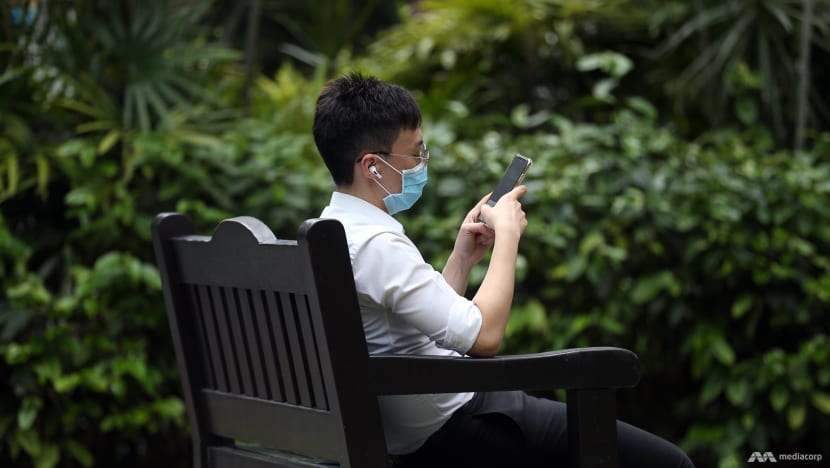Commentary: In Singapore, talented workers can’t wait to quit. They’re just waiting for right offer
The Great Resignation Wave is more a Great Reshuffling of Talent. Organisations must keep their best engaged with new opportunities, says ADP’s Yvonne Teo.

It can be a constant struggle for young adults who are just entering the workforce at a socially distanced era to find meaning and identity in their work, said sociologist Paulin Tay Straughan from the Singapore Management University. (Photo: TODAY/Ooi Boon Keong)
SINGAPORE: You know what’s a real generational change when it comes to work life? The fact that long gone are the days when employees began their careers at and retired from the same company.
On average, people will change jobs 12 times in their lifetime in the US.
While the economic uncertainty caused by COVID-19 initially had employees holding off on career changes, many are now taking the plunge, almost two years into the pandemic.
This wave of employees voluntarily leaving their jobs, dubbed the “Great Resignation”, has been described as a backlog of pent-up resignations.
At a first glance, Singapore appears to be bucking the global trend. Many businesses have been spared from dramatic spikes in turnover rates. In fact, resignation rates in the first two quarters of 2021 have stayed below pre-pandemic rates.
But if global trends hold true, it’s only a matter of time before Singapore sees a new wave of resignations soon.
Still, the drivers might be different. Unlike the US, where stagnant wages, poor benefits and lack of productivity gains have seen people quit in droves, economists have said Singapore’s tight labour market and strict measures on foreign labour mean salaries might surge upwards in search of rare talent.
To fill vacant roles, employers may consider hiring remote overseas talent. Others may take a long-term approach to nurture local talent, by hiring and training fresh graduates or less experienced employees.
REALITY REMAINS THAT WORKERS FEEL DISENGAGED
Singapore has some of the most resilient employees in the world, but they are also among the most disengaged. According to ADP’s Global Workplace Study 2020, Singapore had the sixth lowest employee engagement rate out of 25 countries surveyed, but was only ranked as the fourth most resilient workforce.
Left unchecked, low engagement is an early indicator of eventual burnout and high turnover rates. This pattern is also observed in other research.
In ADP’s annual workplace survey, People at Work 2021, Singapore workers expected themselves to stay at their current organisation for an average of 3.35 years, down from 3.61 the previous year.
Younger millennials, aged 25 to 34, had one of the largest decreases in their projected employment term, from 3.5 to 3.05 years.
The same survey found that approximately one in three respondents from this age group were more interested in contract work, due to concerns about the relative security of traditional full-time employment.
The disruption of the global pandemic has been a pull factor for employees to find different ways to stay employable. Findings also indicated that 59 per cent of Singaporean respondents had considered or made a switch to new jobs or industries, in order to stay future-proof.
Battered by two years of pandemic-related anxiety, along with unclear boundaries and expectations from bosses during WFH, experts have also suggested that “apocalyptic thinking” could be driving employees to quit.
There are common threads running throughout employees’ reasons for resigning, including the ever-present spectre of burnout – leading employees to pursue deeper meaning and satisfaction with life.
All these mean the Singaporean workforce seems to be handling the challenges thrown their way, but are largely “going through the motions” and not especially engaged at work.
Employees are dreaming of carving out new career paths for themselves, and they are more willing than ever to take risks along the way.

THE GREAT RESHUFFLING OF TALENT
Perhaps a new way to look at The Great Resignation would be as a reshuffling of talent - a natural progression from fast-tracking our workforce’s learning and development.
Rather than seeing high turnover rates as a threat, employers could view this as a sign that employees are hungry for fulfilment and career growth defined on their own terms, and figure out how to provide these new areas of job satisfaction.
For employees who are seeking new horizons, companies should offer breadth, depth and accessibility in learning and development opportunities. Healthy challenges can prevent boredom at work.
Organisations should create opportunities for employees to advance their career, be it through “stretch assignments”, specially assigned to push employees beyond their comfort zone, or job rotations to try out new areas of work.
One strategy that businesses can deploy to keep things dynamic for stagnated teams is to introduce exchange programmes, where employees swap ideas and pick up new skills for projects or roles usually handled by other colleagues.
This keeps ideas fresh, encourages greater collaboration, and could open new career paths or responsibilities within the same organisation.
GROWING OPPORTUNITIES FOR LEARNING
Aligning expectations between employers and employees is crucial too. The Monetary Authority of Singapore projects that employment levels will not return to pre-pandemic levels, even by end-2022, partly due to employers increasing labour productivity.
This is not surprising, given the national focus on boosting workforce learning and development – but employers must keep in mind that learning and development should be geared towards future-proofing businesses and employees’ careers, and be wary against increasing workloads.
Adequate training and support must be provided in the bid to increase productivity, and even when employees are able to take on a wider range of tasks with their newfound skills, employers should take caution that they aren’t being overburdened.
About two in three Singapore survey respondents in ADP’s People at Work 2021 survey indicated that they had taken on more responsibilities or taken on new roles due to COVID-19 disruption.
Yet, almost a third (27 per cent) of these respondents stated that they received no additional training or renumeration from their employers.
It is vital for companies to understand that higher productivity should not result from additional work hours, but from a combination of improved processes, effective upskilling, and respect for employees’ well-being.
Employees too should feel appropriately appreciated for their work. In addition to competitive salaries, the most attractive employee entitlements in a post-pandemic workplace will offer personal autonomy of one’s work-life balance.

GIVE EMPLOYEES FLEXIBILITY IN TAKING LEAVE
Take annual leave for example. With snap COVID-19 restrictions derailing plans and schedules, and possibly creating last-minute work tasks, employees need greater flexibility in choosing when to take breaks.
Employees should be assured of having a good support system where teammates can willingly and easily cover each other’s work demands.
Companies need to build a culture of trust and collaboration that empowers employees. Actively consulting employees on working processes – including leave approval and task allocation – is a great opportunity to build such a culture.
The highly volatile post-pandemic era demands greater agility from both employees and employers. Employees are searching for purpose-driven careers that offer flexibility and fulfilment.
Employers who can support this hunger for growth within their organisations will be able to build a highly driven and engaged workforce – one with a greater staying power.
Yvonne Teo is vice-president of Human Resources, APAC at ADP.
























